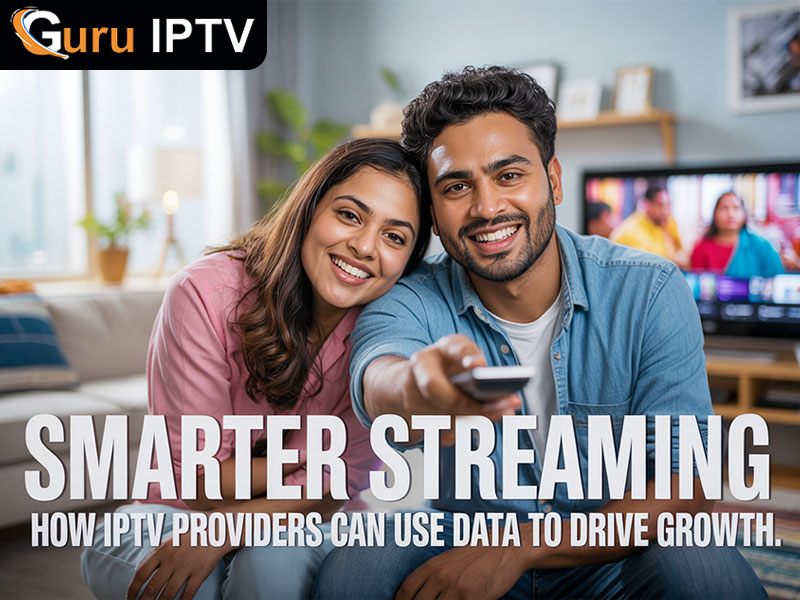Free Express Shipping

The streaming industry has never been more crowded or competitive. With well-established giants and new players entering the scene, every IPTV provider is vying for viewers’ attention in an increasingly crowded marketplace. Whether you’re in the market to purchase IPTV services or you’re a provider trying to stand out, one thing’s clear: success today goes beyond simply offering channels and content.
The real game-changer? Making decisions based on data. IPTV companies around the world are realizing that analytics and predictive modeling aren’t just optional—they’re vital for staying afloat and growing. From the busy IPTV markets in the USA to the diverse entertainment tastes shaping Indian platforms, providers who leverage data are gaining a competitive edge and pulling ahead of the pack.
Modern IPTV streaming platforms are goldmines of information. Every click, pause, skip, and channel change generates valuable data points that smart providers are using to transform their operations. This isn’t just about collecting numbers—it’s about turning those numbers into actionable insights that directly impact the bottom line.
Today’s top IPTV provider companies understand that data analytics serves multiple critical functions:
When customers purchase IPTV services, they expect everything to run smoothly. Buffering, poor video quality, or service disruptions can quickly drive them to switch to a competitor. That’s where real-time data analysis becomes crucial.
IPTV providers that use advanced monitoring tools can spot and fix problems before they impact viewers. For instance, if analytics detect unusual traffic spikes during a big live event, the system can automatically adjust resources to keep the service running smoothly.
The most successful IPTV platforms also rely on predictive models to forecast busy times. By analyzing past data and current trends, they can proactively scale their infrastructure to handle peak usage — like during major sports games or season finales — ensuring a seamless experience even when demand is at its highest.
In markets like IPTV in the USA and Indian IPTV, where consumer preferences vary dramatically, personalization isn’t optional—it’s essential. Data analytics enables providers to create individualized experiences that keep viewers engaged and subscribed.
Advanced IPTV services track detailed viewing behaviors to build comprehensive user profiles. This includes:
A top IPTV provider uses this information to power recommendation engines that suggest truly relevant content, increasing viewer satisfaction and reducing churn rates.
For providers looking to expand or improve their market position, data analytics offers crucial competitive intelligence. IPTV streaming companies can analyze market trends, competitor activities, and emerging viewer preferences to make strategic decisions about content acquisition, pricing models, and feature development.
In diverse markets like TashanTV, where linguistic and regional preferences play huge roles, data helps providers understand local tastes and customize their offerings accordingly. Similarly, IPTV in the USA requires understanding of demographic trends, cord-cutting patterns, and regional sports preferences.
Behind every successful data-driven IPTV service is robust technical infrastructure. Modern platforms need systems capable of:
When consumers buy IPTV services, they’re not just purchasing content access—they’re investing in a technology platform that should improve over time. Data-driven providers can deliver on this promise by continuously optimizing their service based on user feedback and behavior patterns.
The difference between a top IPTV provider and struggling competitors often comes down to how effectively they use data. Leading platforms demonstrate several key advantages:
The IPTV streaming industry continues to evolve rapidly. New technologies, changing consumer behaviors, and emerging content formats require providers to stay ahead of trends. Data analytics provides the foundation for this forward-thinking approach.
Successful IPTV services use predictive modeling to anticipate changes in the market. Whether it’s the growing popularity of short-form content, shifts in live sports viewing, or emerging technical standards, data helps providers adapt quickly and maintain their competitive edge.
Data analytics isn’t just changing how IPTV streaming works—it’s redefining what it means to be a successful top IPTV provider. Companies that embrace data-driven decision making gain significant advantages in service quality, customer satisfaction, and operational efficiency.
For providers still operating on intuition rather than insights, the message is clear: adapt or fall behind. The future belongs to IPTV services that can turn data into better experiences, stronger relationships, and sustainable growth.
In an industry where users have endless options when they buy IPTV services, the providers who use data smartly will be the ones who thrive. The question isn’t whether to invest in analytics—it’s how quickly you can get started.